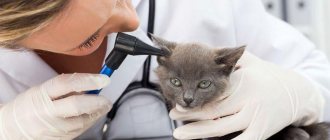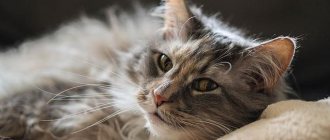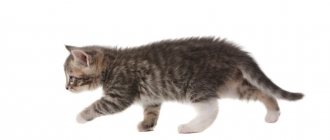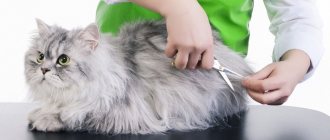As you know, the hearing organs for cats are as important as the sense of smell, sight, and touch.
Unfortunately, even pets that do not leave the apartment are not immune from otitis media. It is necessary to treat otitis in cats at an early stage, since the process from the external auditory canal, in the absence of help, quickly moves to the middle and then to the inner ear. Cat owners, when faced with a similar problem, often ignore the disease or do not know how it can be cured. First of all, it is necessary to find out the cause of the inflammatory phenomenon, but this cannot be done at home, so you should not delay a visit to the veterinarian.
Types of otitis media in cats
Otitis in cats is a disease that is accompanied by inflammatory processes in the ears of animals. Sometimes inflammation develops rapidly (acute course) or occurs almost unnoticed for a long time (chronic course).
The disease can occur at any age, regardless of the gender or breed of the cat. The main risk group includes animals with poor immunity, weakened, and elderly pets.
In most cases, otitis media begins with inflammation of the external auditory canal. If detected early and treated appropriately, the cat will make a full recovery.
If you ignore the symptoms, the inflammation spreads to the middle and inner ear. Inflammation of the middle ear, although it occurs in a more severe form, is treatable in the early stages. If inflammation of the inner ear is allowed, the process may drag on for several months. Otitis media can lead to hearing problems and other complications that can cause the cat's death.
Localization of the inflammatory process:
- external: the inflammatory process occurs in the outer part of the auricle;
- medium: inflammation covers the external auditory canal, descends deep into the auricle beyond the border of the outer ear, right up to the eardrum;
- internal: accompanied by inflammation of the inner ear, including tissues that are outside the eardrum, such as the auditory nerve, cochlea, and ossicles.
The disease usually occurs in one ear, but if treatment is not taken, it quickly spreads to the second ear.
Purulent otitis media
Suppurative otitis is usually localized in the middle, inner ear of a cat. In addition to general signs such as restlessness, itching, there are a number of specific symptoms.
Signs of purulent otitis:
- the animal will tilt its head towards the sore ear;
- redness, swelling of the visible ear coverings;
- hearing impairment, the cat does not respond to the sounds of its name;
- upon examination, an increase in ear temperature is noted;
- increased body temperature;
- pain on palpation of the ear and nearby tissues;
- purulent, bloody or serous discharge from the ear canal;
- the putrid odor of their ears;
- scratches, sores, cracks on the visible part of the auricle;
- inflammation of the submandibular lymph nodes;
- apathy, depressed state, the animal hides in dark, cool places;
- deterioration or complete loss of appetite, vomiting;
- when pressing on the auricle, a characteristic squelching sound is heard;
- lack of coordination;
- salivation, lacrimation, purulent discharge from the eyes;
- the ear droops or bends to the side.
In acute cases (in the internal section), paralysis of the cat's facial nerve is noted. The lip, jaw and eyelid droop (lean) towards the affected ear. When the cerebral cortex is damaged, the animal experiences convulsive contractions of muscle tissue, as well as seizures similar to epileptic seizures.
When the eardrum ruptures, pus can drain not only through the ear, but also flow through the mouth and nasal cavity.
Bacterial otitis
The causes of bacterial inflammation can be microtrauma, ear parasites, fungus, decreased immunity, hormonal imbalance, previous infectious disease, allergic reactions.
In most cases, bacterial otitis in cats develops as a secondary disease when pathogenic microflora enters the animal's body. Bacterial otitis media, typical symptoms:
- restlessness, itching;
- redness, swelling of the internal visible integument;
- wounds, ulcers, cracks, as well as other violations of the integrity of the inner ear.
Typically, bacterial otitis occurs as a complication of infectious diseases of the respiratory system. But there are often cases of ear injury when cleaning the inside of the ear using unsuitable tools and materials.
Fungal otitis media
Fungal otitis media is a fairly serious disease in which immediate care is important. Most likely, surgery will be required, as well as a long course of treatment and rehabilitation. In severe cases, if left untreated, the cat dies.
A number of atypical signs can be misleading, since only veterinarians can make a final diagnosis. Therefore, at the first signs, you need to go to the clinic to undergo an examination and get tested.
Signs of fungal otitis:
- severe inflammation of the internal skin;
- itching, pain on palpation, scratching;
- upon examination, gray-green deposits are visible on the surface of the auricle;
- growths or gouges on soft tissues, which, if left untreated for a long time, can reach cartilage tissue.
In severe cases, the entire inside of the ear canal is clogged with fungal formations similar to mold, cotton wool or filter paper.
Parasitic otitis media
In this case, the main cause of inflammation is Otodectes mites. The disease caused by mites is called otodectosis or ear scabies. Less commonly, the inflammatory process can occur with severe flea infestation, notoedrosis, and sarcoptic mange. The vital activity of mites leads to the development of inflammation on the cat’s skin, increased secretion of sulfur, microcracks, and scratching.
Typical signs of parasitic otitis media:
- small ulcers on the inner skin;
- unpleasant odor from the ear;
- dense dark brown discharge that can completely block the internal auditory canal.
Otodectosis is contagious and is often transmitted from a sick animal to a healthy one, so contact with potentially sick pets should be avoided.
Allergic otitis media
Allergic otitis media develops rapidly from several hours to a day. The disease can develop against the background of food allergies or be a secondary process in ear scabies (otectosis).
Allergic otitis in cats, typical signs:
- severe swelling of the ear tissues, including the auricle, middle, and also the inner part of the ear canal;
- increase in local temperature;
- Watery blisters, ulcers, and scratches appear on the skin;
- with complex development, hair loss on the ears is noted;
- Allergic otitis media is often accompanied by swelling of the eyelids, nose, larynx, and tongue.
The acute course of the disease may be accompanied by serous discharge, unpleasant odor, salivation, lacrimation and other associated symptoms.
Causes of the disease
Otitis media in cats can be caused by factors related to the functioning of the body, as well as environmental influences. These include:
- fleas and ticks. They are carriers of infection. Inflammation and irritation are also caused by waste products of parasites.
- foreign body. Once in the ear canal, small objects cause local inflammation and swelling.
- bacterial infection. Its development is facilitated by hypothermia, lack of vitamins, viral diseases, and weakened immunity.
- allergens. Individual intolerance to certain foods, medications, and detergents causes a release of histamine in the cat, which can result in allergic otitis media.
- parasitic fungi. They cause inflammation, which most often affects the outer and middle parts of the ear.
- neoplasms. Verrucous nevus and malignant tumors under certain conditions provoke an inflammatory process in the tissues of the auditory analyzer.
- injuries. In the absence of proper treatment, damaged skin turns into a fertile environment for infection. This is how bacterial otitis occurs. Inflammation of the internal part can occur due to injury to the temporal bone.
- autoimmune diseases. As a result of the rejection of one's own tissues, inflammation begins in the ear.
- hormonal disbalance. A change in the concentration of hormones (primarily produced by the adrenal glands, gonads, and thyroid gland) can provoke an inflammatory process.
- growth of fur in the ears. The high density of hairs stimulates the ceruminous glands, which produce earwax. This causes irritation and, as a result, scratching of the integument.
global $ads_google; //data-ad-slot=”2475549904″ $ads_google = empty($ads_google) ? false : true; ?> if ($ads_google == false) {?>
$ads_google = true; ?> } ?>
Symptoms of otitis media in a cat
Inflammation of the outer and middle ear can be asymptomatic up to a certain stage, so it is necessary to regularly examine the ears for warning signs.
General symptoms of the disease:
- itching, the animal constantly scratches the ear, shakes its head;
- redness of the visible part of the ear;
- discharge of various types;
- depressed state;
- loss of appetite;
- unpleasant odor;
- soreness, the pet does not allow you to examine the ear;
- cracks, sores, blisters on the skin.
Any symptoms are the first signal that the cat needs to be taken to an appointment with a veterinarian. Only an experienced doctor can make a diagnosis and prescribe treatment!
Diagnostics
A comprehensive approach is required to make a correct diagnosis. The effectiveness of treatment depends on the results of the research, because bacterial otitis and otitis caused by ticks cannot be treated in the same way.
The doctor must collect all the data about the conditions of keeping and feeding the pet, chronic diseases, and behavior. A complete examination of the animal is carried out, the outer ear and ear canal are examined using an otoscope, and the doctor takes a swab from the ear for laboratory examinations.
Additionally, an x-ray may be prescribed, as well as an MRI; tomography will help determine inflammation of the middle ear at the very initial stages, when x-rays are uninformative.
Treatment of otitis media in cats at home
It is better not to self-medicate, especially in severe cases. But if the overall picture of the treatment is favorable and the cat feels well, then you can relieve minor inflammation and help the cat with folk remedies.
Treatment of otitis with folk remedies:
- Fungal otitis in cats: an alcoholic infusion of calendula is instilled into the ear. At the rate of 1 teaspoon of tincture per half glass of water.
- Relieves inflammation: geranium juice, boiled bay decoction (3 leaves per 100 ml of water), propolis tincture in water.
It is advisable to use all medications and traditional methods only after consulting a veterinarian. Since self-medication can lead to a deterioration in the cat’s condition and the development of secondary diseases.
Tick exposure
Many owners mistake this discharge for dirt or consider it a temporary phenomenon. Daily cleaning does not give any results, and in the morning there is again unpleasant discharge in the ears and the wound in the cat’s ear does not heal. You should contact a specialist to remove the parasite from the ear at a professional site.
The duration of the treatment will not take much time, and includes instillation of specialized drops and cleansing of the ears of cats.
Hematoma of the head, as a reason why the ear rots
The so-called mechanical impact on the auricle can be caused by severe injuries, insect bites or serious scratching.
If the disease is not detected in time and treatment is not started, the process can lead to serious complications. After all, a cat, experiencing discomfort, can often inflict additional injuries on itself, followed by even greater rotting of the ear. That is, the appearance of pus in a cat’s ear is an unpleasant, but expected measure.
Here the treatment is not at all complicated and is regulated by the following rules. If less than two days have passed, then at home the owners apply cold and make a specialized bandage. After 24 hours, on the contrary, if negative factors do not appear, they use heat and soothing ointments.
If the treatment process does not produce results, then you should take the cat to a doctor, who will take the necessary measures to eliminate the consequences of the hematoma and tell you how to treat the cat.
Necrosis of the ears
It can be caused by prolonged compression, a transitional process of decay from surrounding tissues, or the penetration of pathogenic microflora into the body.
Patients can only be treated by surgical intervention by amputating the auricle or its damaged part.
Also, one of the popular reasons for rotting of the ears is the presence of foreign bodies in them.
After all, prolonged exposure to such a thing leads to inflammation and the subsequent process of rotting.
The most important rule for detecting rotting in cats is not to procrastinate and take timely measures to rid your pet of unpleasant sensations.
Prevention of otitis in cats
To reduce the risk of developing the disease, it is necessary to follow preventive measures.
Prevention of the disease:
- Follow hygiene procedures.
- Conduct preventive examinations. On your own once a week and at least once every six months with a veterinarian.
- Do not allow water or foreign objects to get into the ear.
- Avoid hypothermia and drafts.
- Watch your diet.
- Follow the schedule of antiparasitic treatment and vaccination.
- Avoid contact with stray animals.
Otitis media in cats is not dangerous to humans, but can cause infection in other pets. After all procedures, you must wash your hands with soap and treat with a disinfectant. Contact with other pets should be avoided. Provide the cat with peace, good nutrition and a cozy atmosphere in the house.











